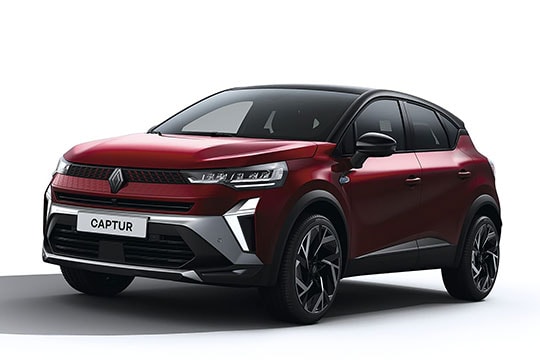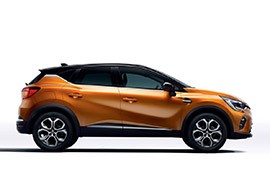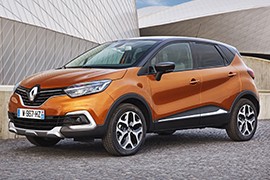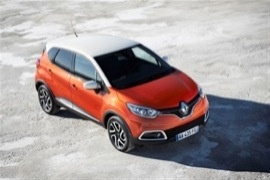RENAULT Captur Models/Series Timeline, Specifications & Photos
First production year: 2013
Engines: Gasoline, Liquefied petroleum gas (lpg), Mild hybrid, Hybrid gasoline, Diesel
Body style: Hatchback
Renault refreshed one of the most popular B-segment crossovers from Europe, the Captur, in the spring of 2024, and the changes were significant.
The French automaker introduced the Captur’s first generation in 2013, using the same platform as the small-sized hatchback Clio. This B-segment crossover was Renault’s answer to fast-growing B-segment vehicles, suitable for the urban environment and perfectly capable of tackling some unpaved roads. Even though it wasn’t offered with an all-wheel drive system, it was attractive for those looking for a car with a higher ground clearance than regular hatchbacks. In addition, its exterior sizes recommended it for tight parking spots, while the interior was pleasant, even though it wasn’t fitted with the best materials in the industry. Then, in the summer of 2019, the automaker brought the second iteration of this nameplate, which was also offered under the Mitsubishi badge as the ASX’s second generation. In the spring of 2024, the car got a well-deserved refresh.
Its front fascia took inspiration from the Renault Megane e-Tech and sported narrow, LED headlights with a sharp design. It flanked a grille designed with oblique slats where the Renault rhomboidal badge took center stage. On the lower side of the bumper, the automaker placed a trapezoidal air intake that looked like a shield and was flanked by angular tall daytime running lights. As a result, the friendly face of Captur’s first generation morphed into aggressive styling with a distinct personality.
On its profile, the car sported black side sills and wheel arches trims, creating an image of a vehicle with a higher ground clearance. Its sculptured door panels followed an ascending line, giving the impression of a dynamic crossover. Like its predecessors, it was available with a black roof and pillars that created a floating roof design. Finally, at the back, Renault put C-shaped taillights extended from the quarter panels onto the tailgate while a black trim adorned the lower side of the bumper. The car was available in three grades, Evolution, Techno, and Esprit Alpine, fitted with wheels between 17 and 19 inches, in a range of six body colors and two-tone bodywork for a total of 17 configurations.
Renault made massive changes for the 2024 Captur. Customers were greeted by a redesigned dashboard, which featured a 10.25” TFT display fronting the driver in the instrument cluster. At the same time, atop the center stack, the automaker placed a 10.4-inch portrait-mode touchscreen for the infotainment system, named OpenR Link. It was compatible with Android Auto and Apple Carplay for wired and wireless smartphone connectivity. Regular bucket seats were available for the Evolution and Techno grades, while the Esprit Alpine featured high-bolstered seats that provided increased side support. But Renault didn’t forget about the usability of this vehicle and provided it with a sliding split-folding bench in the back for three adults. When not in use, with the entire seatback lowered, the cargo capacity reached 616 liters (21.8 cu-ft).
Under the hood, Renault installed a choice of seven engines ranging between 91 PS (90 hp) and 162 PS (160 hp) paired with manual or automatic transmissions. The most significant upgrade was the new 147 PS (145 hp) full-hybrid drivetrain with a serial-parallel architecture. The 1.3-liter turbocharged non-hybrid version was not available on all markets.
This is the best selling model in the c-SUV segment in Europe. It pioneered this segment and now it owns it. Actually, it is so well sold that it will be manufactured in China, where Renault has a very important market.
When it was launched back in 2013, it didn't have too many engines and variants. It was based on the B platform from the fourth generation of the Clio.
The 2020 model is based on the fifth generation of the Clio platform, the same used for Nissan Juke. On the outside, there are new headlights, in the same style with the compact class Megane and the Clio. A bigger interior was possible due to the CMF-B platform, which is modular and can be extended.
For the engines, Renault announced that a plug-in version will be made. Thus, this will be the first car in its segment with a plug-in hybrid version. The other engine choices are either gasoline or diesel. Their power will range between 100 and 155 hp. No all-wheel-drive version was announced.
Inside, there is a new interior with more focus on infotainment and passenger comfort. In front of the driver, in the instrument cluster, there is a TFT screen that can show turn-to-turn navigation and various other information for the driver. On the center console, there is the EASY LINK infotainment system. It is available in two sizes of 7” and 9.3” and supports Android Auto and Apple CarPlay. The sound system is signed by Bose.
Based on the same platform as the Renault Clio IV, the Captur was the best selling crossover on the European market. It offered more interior room than its smaller brother and a good taste for adventure.
The Captur was proof that a crossover doesn't need to be all-wheel-drive to be successful on the market. It had to be good in city traffic, easy to park, and able to jump over a curb without damaging the bodywork or the side sills. The 2013 model was facelifted in 2017 and it brought some improvements in all areas.
The long-Clio-on-stilts Captur took the B-Platform from the Renault-Nissan alliance and improved it with a better-looking bodywork. There was a new set of headlights. The DRLs were on the lower side of the bumper and when lit, they formed a “C” letter. A wide lower grille was installed between them. From the side, the wave-like sculptured doors made the car looks longer than it was. In the back, a roof-spoiler was installed over the rear windscreen. The rear bumper was redesigned as well.
Inside, the 2017 Captur received more options to upgrade the driving experience and onboard comfort. The instrument cluster featured two dials: one for the tachometer and the other for the fuel level. Between them, on an LCD, there was a digital speedometer. The front bucket seats were available in six different customization packs, with different colors. In the back, there were not too many improvements, apart from the upholstery.
Under the hood, the 2017 Captur was offered with a choice of diesel and gasoline engines ranged between 90 hp and 120 hp.
The fast-growing cross-over market trend made Renault extend the wheelbase of a Clio, put it on stilts, and reshape the bodywork. And that's how the Captur was born.
It was one of the most popular crossovers in Europe. The low-cost, high seating position and fuel-efficient engines were the main advantages of the Captur.
It is hard to tell that the Captur front fascia smiled or was angry. The angled headlights bumper-integrated DRL with LED and two-tone bodyworks were quite attractive to some. The lips-like grille was enlarged in the middle like a kiss. A kiss that wore the rhomboidal Renault badge.
Inside there was a big drawer-like storage compartment, but only for the left-hand drive vehicles. An infotainment system was able to connect to Apple CarPlay and Android Auto. An interesting feature of the audio system was a sound emulator that sent a different engine roar into the speakers and it revved according to the actual engine speed. Rear parking sensors and a reversing camera were available as part of the MEDIA NAV or RLink packs that were offered as standard or optional, depending on the trim level. For the rear seats, the bench was moving back and forth to offer more legroom for the passengers.
But under the hood, there was a fair variety of engines, both gasoline and diesel and some of them could have been mated to an automatic transmission. The front McPherson struts and the rear trailing arms suspension was good for driving in and around cities. On the long run, the 2.6 meter (102.3") wheelbase was good and the stiffer suspension promised a low body-roll.



